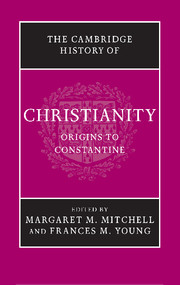Book contents
- Frontmatter
- Prelude: Jesus Christ, foundation of Christianity
- Part I The Political, Social and Religious Setting
- 1 Galilee and Judaea in the first century
- 2 The Jewish diaspora
- 3 The Roman empire
- Part II The Jesus Movements
- Part III Community Traditions and Self-Definition
- Part IV Regional Varieties of Christianity in the First Three Centuries
- Part V The Shaping of Christian Theology
- Part VI ‘Aliens’ become Citizens: towards Imperial Patronage
- Conclusion: retrospect and prospect
- Bibliographies
- Index
- Map 1. The Roman Empire in the time of Marcus Aurelius
- References
1 - Galilee and Judaea in the first century
from Part I - The Political, Social and Religious Setting
Published online by Cambridge University Press: 28 March 2008
- Frontmatter
- Prelude: Jesus Christ, foundation of Christianity
- Part I The Political, Social and Religious Setting
- 1 Galilee and Judaea in the first century
- 2 The Jewish diaspora
- 3 The Roman empire
- Part II The Jesus Movements
- Part III Community Traditions and Self-Definition
- Part IV Regional Varieties of Christianity in the First Three Centuries
- Part V The Shaping of Christian Theology
- Part VI ‘Aliens’ become Citizens: towards Imperial Patronage
- Conclusion: retrospect and prospect
- Bibliographies
- Index
- Map 1. The Roman Empire in the time of Marcus Aurelius
- References
Summary
The gospels provide contrasting theatres for the public ministry of Jesus. Whereas the Synoptics have a shared focus on Galilee, with one final journey to Jerusalem, the fourth gospel views Galilee virtually as a place of refuge from a ministry conducted for the most part in Judaea and Jerusalem. In the most recent wave of historical Jesus research, there has been a marked preference for Galilee, due to a variety of factors, not the least of which are current trends among scholars interested more in the social than the theological significance of Jesus’ life. Historians are missing an important clue to his career, however, if they ignore the fact that it was in Jerusalem rather than in Galilee that he eventually met his fate.
Geographical factors
As one moves from west to east, both Galilee and Judaea follow a similar pattern in geomorphic terms – coastal plain, central hill country, rift valley and the uplands of Transjordan. On a north–south axis, however, real differences emerge due to the variety of climatic conditions. The marked decrease in annual rainfall from north to south is quite obvious in the landscape. Whereas the central Galilean hill country, with its rich alluvial soil and many springs, has a number of wide valleys running in an east/west direction, the Judaean hill country has much less soil covering and tapers off quickly into the dry, arid desert region of the Dead Sea valley.
Keywords
- Type
- Chapter
- Information
- The Cambridge History of Christianity , pp. 35 - 52Publisher: Cambridge University PressPrint publication year: 2006



